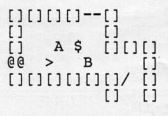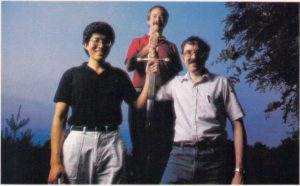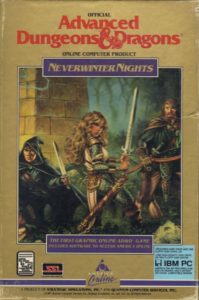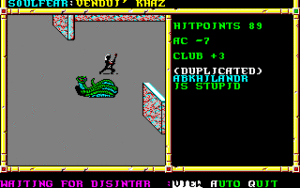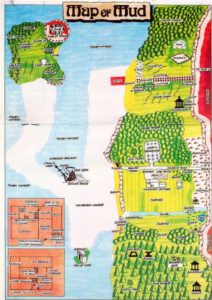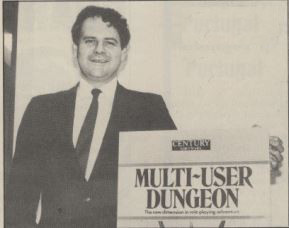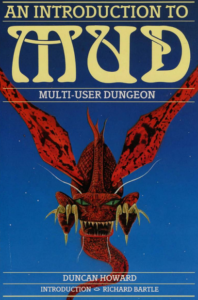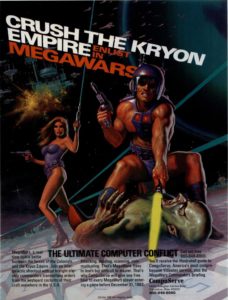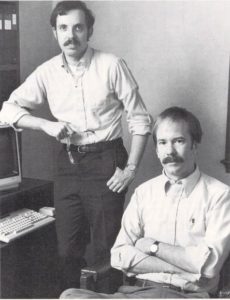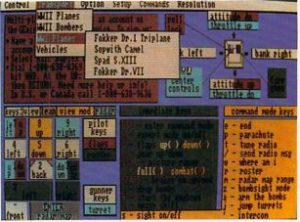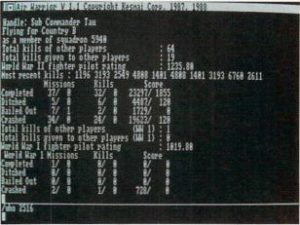Coming exactly halfway between the shuttering of Infocom and the release of Graham Nelson’s landmark epic Curses, 1991 was the most exciting year of the little-remembered interstitial between interactive fiction’s commercial era and its supposed rebirth as an endeavor of dedicated hobbyists. The games of 1991 show what a misnomer the word “rebirth” really is in this case; the text adventure never actually went away at all. The tools available to amateur authors were certainly rougher than they would be in years to come, design standards as well less thought-through, but the fact remains that not a single year has gone by since Adventure first took the computing world by storm in 1977 when at least one or two worthy text adventures haven’t been written. In fact, hobbyists did considerably better than that in 1991. Amidst its blizzard of activity, that year yielded the four games I’ll be writing about today: two classics, one enjoyable journeyman, and one heart-breaker which came that close to being one of the finest text adventures ever written. Not bad for a dead form, eh?
Cosmoserve
It seemed like such a good idea at the time.
As a self-employed computer consultant, working at home was the logical decision: no more long commutes, no expensive office to lease, no boss. Unfortunately you also have no secretary, no janitor and no weekends. Your living room has become a glorified break room and your only human contact is by Electronic Mail.
Thank God for your computer.
It is 3:30pm on Friday the 7th of September, 2001. Everyone else in your time zone is finishing up work and looking forward to a relaxing evening. But you, R.J. Wright, overtired undernourished overeager programmer that you are, have promised to deliver a finished program to a client by 8:00 tomorrow morning.
Time to get to work....
I’ve always been entranced by the personal aspect of so many vintage text adventures of the amateur stripe. In this respect, they stand apart from almost all other games of their era, which preferred to emphasize the science-fictional, the fantastical, the epic. Even when those other games aren’t demanding that we leave the world we know for some strange new one, they almost always prefer the macro to the micro: wars and battles lost and won, the rise and fall of civilizations, the grand sweep of history. But text adventures, by contrast, can give us an intimate view of a single person’s life, whether said life be that of a PhD student at Harvard or a community-theater volunteer in a small California town. To state the case in literary terms, these are the quieter novels of ordinary people that, for some of us at least, become far more interesting than the latest swords-and-sorcery doorstops as we get older.
Cosmoserve, a game written in AGT by a Celtic harpist and sociologist-to-be named Judith Pintar, has the added advantage of providing a window into a world I’ve just spent the last two months on this blog doing my level best to capture: that of the commercial online services of the 1980s and early 1990s, which pioneered so much of what has since become daily life on the Internet. The game’s title is of course playing on that of CompuServe, the most popular of these services for well over a decade, and a service to which Pintar herself was an active subscriber for many years.
Cosmoserve is ostensibly set in 2001, but we can’t award Pintar too many points for her skill at prognostication. She manages to simultaneously underrate and overrate the pace of technological change to come. In her version of 2001, the wide-open World Wide Web never came along to bury the closed ghettos of the commercial online services, Windows never entirely replaced MS-DOS, and Intel never abandoned their old “x86” nomenclature for their microprocessors. And yet, at the same time that Pintar’s fictional universe was progressing more slowly than ours in all these respects, full-on online virtual realities — the sort of thing that’s just starting to become imaginable for us in 2017 — had already become a thing there by 2001.
But then, prognostication isn’t the point of Cosmoserve. Rather than an extrapolation about computing’s future, what you’re actually getting here is a gentle satire of the computing present which Pintar knew as she was writing the game. If you were already a computer freak in 1991, you’ll find yourself chuckling at things that are barely remembered today but were a major feature of the landscape of those times. For instance, do you remember the way that Intel, thanks no doubt to some marketing genius of an MBA inside the company, used to release crippled “SX” versions of their latest chips — versions that in some cases actually performed worse than the chips of the previous generation? I barely did myself, until Pintar reminded me:
This is the newly-released Orfland 786SX. Most of the advanced features of the revolutionary 786 chip were factory-disabled for the SX model: it hasn't got enough memory to run a graphical interface and it chugs along at about 12Mhz, but hey, its still a 786!
The plot of Cosmoserve is a classic shaggy-dog story in text-adventure form, the same approach that would be used to more famous effect by Curses two years later. Playing the role of a harried free-lance computer consultant, you need to get a patch for Turbo Pascal — another blast from computing’s past; the Borland product was by far the most popular development tool in the world in 1991 — in order to complete an assignment for an important client. You should be able to get the patch on Compu… err, Cosmoserve. It’s when you fire up your computer to go online and fetch it that the game, after having started out as a slice of life set in your own house, begins to show its real cards.
Most of Cosmoserve plays as a simulation of that whizz-bang Orfland 786SX computer of yours. First you’ll have to navigate the DOS prompt to get yourself online; in the some-things-never-change department, remembering your password will pose a particular problem on that front. Then, once you do manage to get online, the simulation extends yet one level deeper, allowing you to roam the Cosmoserve service, visiting forums, chat rooms, file libraries, email — all the things I’ve spent so many recent articles describing — along with a few futuristic touches, like the virtual-reality area, presented in recognition of the fact that we’re allegedly in 2001. It eventually emerges that getting the Turbo Pascal patch and finishing your assignment will first require you to stop a computer virus that threatens to take over the world. For those who aren’t aware: yes, viruses were already a problem in 1991. I really could go on forever about this game’s palimpsest of the familiar and the obscure, how it constantly signals all the ways things have changed in computing and all the way they’ve remained the same.
As a purely technical achievement, Cosmoserve is remarkable, especially considering that Pintar wasn’t an experienced programmer. AGT was by the standards of text-adventure authoring systems to come a very primitive tool indeed, riddled with assumptions about the sorts of games it would be used to create that can be almost impossible to completely override. And yet Cosmoserve manages to push AGT farther out of its comfort zone than any other game I’ve ever seen. If its simulations of DOS, of a terminal program, of CompuServe/Cosmoserve itself — even of a text adventure within this text adventure which you can play from the DOS prompt — aren’t always perfect, they’re far better than they have any right to be.
From the standpoint of the modern player especially, Cosmoserve does have some drawbacks. It’s never an unfair game according to its own old-school lights, but it is a demanding one. If you’ve never used MS-DOS, or have forgotten everything you once knew, you’ll likely have to consult a reference manual in order to get anywhere at all. And you’ll certainly have to pay careful attention and make some notes if you hope to solve this one.
More controversially, Cosmoserve plays on a clock. Timing is tight, you have a lot to do, events happen online at specific times… meaning, yes, this is one of those try-and-try-again games which require you to make a series of losing reconnaissance runs to get the lay of the land before you put everything together for your victory dash. This design approach is absolute anathema to some people; if you’re one of those people, nothing I can say will persuade you otherwise. The good news, though, is that in this case at least I don’t really have to.
Judith Pintar revisited Cosmoserve in 1997, adding some further polish to the experience and, most importantly, greatly easing the time pressure. Which version you choose to play must be a reflection of your own preferences as a player. Personally, having been raised on the Infocom mysteries, I don’t mind the try-and-try-again approach overmuch, if it’s done within reason and if I know what I’m getting into. I thus actually prefer the earlier Cosmoserve, which feels like a purer expression of its designer’s original intent to me. But of course those of you who aren’t as old-school — masochistic? — as me should feel free to go for the later version.
Either way, I think you’ll find the experience worthwhile. Whether considered as a pure gaming challenge or as a cultural artifact of its very specific time and (virtual) place, Cosmoserve has a lot to offer; taken on either terms or both, the wit, humor, and humanity of its author shine through. It was given co-winner status in the 1991 AGT Competition, alongside a more traditional text adventure called The Multi-Dimensional Thief. The latter game, a confusing mashup of Guild of Thieves and The Wizard of Oz that delights in insulting its player when it isn’t dead-ending her, hasn’t aged very well. Cosmoserve, on the other hand, has only become more essential as the online life it chronicles has faded into oblivion and its time-capsule qualities have come to the fore.
Although either the original or the updated version of Cosmoserve can be played most easily on modern computers using the AGT interpreter AGiliTy, you’ll lose much of the atmosphere provided by occasional sound effects, not to mention MS-DOS’s familiar old green text on a black background. I therefore recommend playing it under the original AGT interpreter, in DOS, to get the full effect. To make that as easy as possible for you, I provide versions of Cosmoserve and Cosmoserve 97 — take your pick — ready to run in the DOSBox emulator. Whether you have a Windows, MacOS, or Linux machine, just install the version of DOSBox for your platform and follow the instructions included in the zip file to get the game going.
The Dungeon of Dunjin
You are in a dark, mysterious and confusing forest. Tall fir-trees form a dark wall around you. A cold wind is blowing from the mountains, and in the far distance you can hear wolves howling. Faint trails lead east and south. To the north the forest seems to continue forever, and to the west the vegetation is so dense that it would be impossible to go in that direction.
If you’re anything like me, you may prefer the idea to the reality of the sprawling text adventures that ran on the big institutional computers of the 1970s. Still some of the largest works ever created in the medium of text and parser, games such as the original Zork and Acheton offer immense worlds of hundreds of locations and almost as many puzzles — worlds to get lost inside for weeks or months. They seem absolutely amazing at first. When you start to play them a little more, though, you come to realize that you just can’t trust these games. Standards of good and bad design simply didn’t exist at the time they were being made, meaning that they tend to be riddled with as many terrible puzzles as brilliant ones.
The Dungeon of Dunjin, written by a Swede named Magnus Olsson over the course of about five years, answers the question of what Zork might have been like if it hadn’t, as Robb Sherwin once so memorably put it, hated its player. The setup is as old-school as it gets: you, the nameless faceless adventurer, have arrived near the entrance to the titular dungeon with treasure on your mind. As you play, another plot line does begin to emerge, but it never feels all that compelling. At bottom, The Dungeon of Dunjin is best accepted as a game about looting a landscape and dropping your spoils in a repository for points — a concept that was beginning to feel a little retro already by the time Infocom left Zork behind in 1983. Olsson’s 1991 backward glance comes complete with a sprawling geography of some 180 rooms, filled with locations that in typically old-school fashion often fail to connect with one another in the expected ways; going south and then going north, in other words, isn’t guaranteed to return you to your starting position. (In light of this, you’ll wind up happy that the game engine doesn’t recognize secondary compass directions like northeast.) Needless to say, light sources, trolls, and dragons figure prominently in the puzzles and plot.
But the thing that separates The Dungeon of Dunjin from its legendary forebears is that all the really annoying old-school nonsense is blessedly missing. Olsson has clearly made a conscious, thoroughgoing effort to design a game that the motivated player can actually win, and without being bored to death by petty logistical problems in the process.
The game engine is home-grown, written in Turbo Pascal. (I did tell you it was everywhere in the early 1990s…) It’s nowhere close to the level of even the PDP-10 Zork, possessing only an extremely basic world model and a parser that’s for the most part limited to two-word verb-noun constructions. Many a designer forced to work with such an engine has wound up stretching it past the breaking point, stumbling into the territory of guess-the-verb puzzles and sheer logical incoherence in an attempt to make a more difficult game than the engine can really support. (I would argue that the entire Scott Adams catalog after the fifth or sixth game can be seen as extended proof of this thesis.) But Olsson is too smart to be caught in that trap: he knows how to work within his tools, avoiding puzzles — like those involving intricate mechanical manipulations — which his game engine just can’t handle. There’s enough that it can do, he realizes, to make a perfectly satisfying old-school adventure game.
The most unfortunate aspect of the writing actually comes right up front, in the horrid title. The Dungeon of Dunjin is no literary masterpiece — that’s hardly the point of a game like this one, is it? — but the writing acquits itself surprisingly well for that of a non-native English speaker. (Olsson does poke a little fun at the thing many people still think of first when they think of Sweden by making one puzzle revolve around an Abba record.) Like Adventure and Zork before it, the game never takes itself too seriously, freely mixing contemporary culture with high fantasy, placing computer labs practically next door to slavering dragons. Sometimes a sly Zorkian wit peeks through, as when you find a human skull in the dungeon that’s made of plastic and has “Made in Taiwan” printed on the side. The dungeon itself, meanwhile, proves in the end to be a closed-down tourist attraction; shades of the bizarre postmodern endgame of Adventure.
Filled with little homages to its predecessors like these, but perfectly playable if you don’t know a rusty rod with a star on the end from a lonely white house, The Dungeon of Dunjin is one of the better old-school puzzlefests I’ve played in my time, consistently surprising and amusing, consistently challenging — not least as a result of the combinatorial explosion that stems from its considerable size — and yet never insurmountable and only very rarely actively annoying. I enjoyed playing it immensely, and fancy that any of you who are up for a big adventure that will absorb quite some hours of your time and who don’t mind making a map and checking it twice — thankfully, we have Trizbort these days! — may just do so as well. Being a native citizen of MS-DOS, it can only be played through an emulator on modern computers. I’ve therefore prepared a version for you that will make that as easy as possible. Just add DOSBox.
Save Princeton
According to the brochure that the admissions department gave you, Princeton University is one of the last bastions of intellectual pursuit, where students can engage in the quest for learning unencumbered by worldly cares. As far as you can tell, though, the place looks like any one of a thousand clones of Cambridge University that clutter the American academic landscape. Still, you figure there must be something at least vaguely interesting about it, considering the reputation that the place has managed to accumulate over the past 250 or so years.
You decide, therefore, to take an Orange Key Tour. Minutes into it, though, you realize that you have no interest in being shown buildings with cannonball scars from the Revolutionary War. So, as the guide leads you through yet another archway, you break off from the group and wander through a nearby door. You find yourself in an entryway, standing in front of a door labeled with the number 21. When you turn the handle, the door swings open, and you enter, hoping no one will catch you being a voyeur.
As you poke around, the sound of gunfire coming from outside in the courtyard startles you. You dive for cover beneath a desk and remain there, shaking, until the tumult dies down. When you come out, you can sense a tension in the atmosphere. Clearly, something strange has happened.
Written by a Princeton University student named Jacob Weinstein with some assistance from his fellow student Karine Schaefer — “she just helped plot it, and left the geeky stuff to Jacob” — Save Princeton is another entry in a weirdly overstuffed sub-genre of interactive fiction: the collegiate text adventure, a category that includes such earlier classics as The Lurking Horror and A Dudley Dilemma. This game isn’t on the same level as either of those, but it has its charms.
As soon as you start Save Princeton, you’re smacked in the face with how much some things have changed since 1991; a plot involving terrorists taking over a major university would never be treated so flippantly in these times of ours. Here, though, it’s just a mechanism for pushing you to explore the campus and lap up — or, more likely, scratch your head at — the endless in-jokes. While nothing really stands out about the game’s puzzles or construction, there’s nothing notably objectionable either; this is all pretty standard fare, albeit delivered in a pretty user-friendly way, without the inscrutable puzzles, mazes — well, there is a fake maze — or parsing issues that were still typical of most amateur text adventures of this era. Doubtless helping the game’s cause is the fact that it’s written in TADS, a much more powerful and polished system for programming text adventures than AGT, if also a much less popular one in 1991. The writing is actually more ramshackle than the technology or the puzzle design, with the tossed-off feel that was also so typical of early amateur text adventures.
But it isn’t Save Princeton‘s merits as a piece of timeless game design, much less as a piece of writing, that makes me want to cautiously recommend it. It rather comes down once again to that personal quality of so much amateur interactive fiction.
Weinstein fills his slice of life not just with the architecture of Princeton, nor just with the pop-culture detritus of 1991 — “there are posters of such charming items as Laura Palmer’s corpse” — but with himself, along with the friends he has at university. Go to the “Girls’ Common Room” and there’s Lisa, “working on the New York Times crossword puzzle”; there’s Melisande, “buried in an Orson Scott Card novel.” Go to the boys’ room and there’s Eric, “humming the violin part of The Rite of Spring“; there’s Otis, the “fairly accomplished computer programmer” who “won the Mr. Princeton bodybuilding contest his freshman year.” Eventually you’ll also meet Karine — yes, Weinstein’s alleged coauthor — sitting in the romantic glow of a lava lamp, dreaming of Anthony Hopkins of all potential heartthrobs, “making an acidic comment regarding the cultural inferiority of every city in the world except for New York.” Somehow I suspect that Jacob was crushing hard on Karine, to the point of giving her a dubious authoring credit on his game, only to be stuck permanently in the Friend Zone.
Of course, I don’t really know what was going on with any of these young people. Nor have I ever even been on the Princeton campus, meaning that every in-joke is utterly lost on me. And yet — and you can chalk this up to my going all American Graffiti in my middle age if you like — there’s something about this unassuming little game that I find almost unbearably poignant. It so happens that I’m almost the exact same age as the kids we meet in it, and I can’t help but feel a connection with all these entitled little dreamers, so full of grand plans for the future, so convinced that the meaning of life can be revealed to them by the right song, book, or film. Where have their lives taken them? If they were given this game to play today, would they be surprised to meet the people they used to be?
Call me a sentimental fool, but Save Princeton, patently envisioned by its author as just a light-hearted adventure game, kind of puts a lump in my throat. Your own mileage may of course vary, but it’s certainly not a bad little game even if it doesn’t prompt in you the same ruminations about the cycle of life. You can download it from the IF Archive and play it using any of the many freely available TADS interpreters.
T-Zero
You awake from uneasy dreams. Since you're no longer on easy street, maybe that's the way your dreams are going to be from now on. Exactly where you are becomes clear as you sort out the sounds of the river to the east, the rustlings of birds to the north and west, and the sweet scent of sleep-inducing poppies wafting down from the northwest. Apparently, after a day of determined walking about, you burrowed down next to the river and let consciousness drift.
What exactly induced this bout of walking? Well, two nights ago, Count Zero handed you your walking papers and extracted your latchkey to the museum in exchange (little does he know that you keep a spare hidden in the topiary). It's just as well that you were dismissed from the museum--your duties as combination custodian and librarian involved either re-shelving books and dusting off clocks or rewinding timepieces and dusting off books. However, you were onto something. Exactly what is unclear since the pieces of the puzzle seem to disconnect with sleep. You resolve not to sleep until you've recollected and reconnected their jagged edges. You can be just as calculating as the Count. You can even reach beyond the Zero . . .
I had one of the most magical gaming experiences of my life with T-Zero.
About fifteen years ago, I was working the graveyard shift at a computer-services firm in Dallas. From 7 PM to 7 AM, three or four nights per week, I’d sit in a nearly deserted data center babysitting the servers and mainframes, just in case anything should happen. Most of the time, it didn’t, meaning I had a lot of free time on my hands. Boredom was a big problem. There were enough curious eyes wandering about the place doing their system modifications and whatnot that playing anything that looked like a game would have been a really bad idea. Text adventures, however, were a different story. I could sit typing away into a window filled with text, looking for all the world like I was hard at work on something vital. Thus I played a lot of text adventures during this period, delving back into a lot of forgotten games — often justifiably forgotten! — from the early issues of SPAG magazine. One of the games I played was T-Zero.
I was playing it one night when a message popped up out of nowhere, apropos of nothing I was actually doing in the game at the time. “It’s a full moon tonight,” it read. “Go outside and take a look.” So, curious whether this already very old game knew what it was talking about, I did.
Well, the game did know what it was talking about. Outside a huge harvest moon hovered low over the warm night. I’d always loved the silence of the predawn hours, when the only sounds you could hear were the omnipresent Texas crickets. Now the peaceful scene, blanketed in the moon’s silvery sheen, seemed to fuse with the peculiar beauty of the game I’d just been playing. I stood there in front of my employer’s antiseptic corporate building for quite some minutes, marveling at the beauty that can visit us at the most banal times. As I turned to go back inside, I knew that I’d never forget this night. And, as this little reminiscence demonstrates, I was right.
T-Zero truly is a magical game in some ways; at its best, it almost attains the same heights as Trinity, my all-time favorite work of interactive fiction. Indeed, comparisons between the two works strike me as unavoidable. T-Zero at the time of its release had the most subtly textured writing that had been seen in a text adventure since Trinity. More than that, though, it resembles and even pays homage to Infocom’s finest hour in many respects: a sundial and a gnomon, to name an obvious if superficial example, figure prominently in T-Zero as well as in Trinity. Less superficially, both games share an abiding obsession with the mystery of time, and both have a smile-through-tears quality, a gentle whimsy laced with melancholia.
T-Zero was written by one Dennis Cunningham, a person about whom I know nothing beyond his description of himself as “a programmer with literary leanings.” He is or was obviously very talented in both fields. For someone like me who loves words, T-Zero is a source of constant delight. As an example of its love of clever wordplay, consider that you begin it by waking up in the location known as “River Bed” — or consider the “buxom bell” you’ll soon be ringing. Unlike so many self-consciously “literary” interactive works, which tend to get buried under the weight of their own aspirations, T-Zero‘s writing dazzles without ever seeming to try to do so; Cunningham’s writerly touch is light where the others are heavy. I can perhaps best convey his game’s atmosphere by borrowing a line from one of his room descriptions: “Either your vision is becoming near-sighted or this scene has all the pointillist charm of a Monet painting.” Like an Impressionist painter, Cunningham is more interested in the interplay of light and shadow than he is with concrete forms. Maybe that explains why the moonlight affected me so on that one magical night.
I hesitate to trample over the delicate poetry of T-Zero too much more with my leaden reviewer’s prose, but will note that it takes place in the slightly surreal landscape which surrounds a strange museum where you until recently worked as a low-grade custodian and librarian. You will eventually learn that the time is out of joint, and you will have to learn to travel through time to visit the same locations in other millennia, learning of the other inhabitants who dwelt and will dwell here. These inhabitants are not human; nor is it ever entirely clear whether you yourself are. Again, T-Zero isn’t concerned with the concrete. It’s a dream and a meditation, and it’s all the better for it.
T-Zero has a spirit of unabashed intellectualism to it — a complete disinterest in talking down to its player — which looks forward to Graham Nelson’s Curses. Cunningham peppers his game with allusions: to Miguel de Cervantes and his deluded knight, to Edgar Allan Poe and his bells ringing in the night, to Douglas Hofstadter and his Eternal Golden Braid, to the Beatles and their Walrus. This sort of thing can veer into rank pretension in a hurry. But, again like Nelson, Cunningham’s erudition reads as intriguing rather than off-putting, sending you scurrying off to Wikipedia to learn more about the references you don’t entirely get.
With so much going on at the literary level, it may seem almost belittling to focus on the technology that underpins the game, but I’d actually be doing its author a disservice not to mention it. Like Magnus Olsson, Dennis Cunningham chose to write his game from scratch rather than use a text-adventure authoring system like AGT or TADS. And here I have to break out the superlatives yet again: the engine he created is quite simply the best bespoke text-adventure engine I’ve seen. Ever.
Cunningham doesn’t just meet the Infocom standard that was still the aspirational ideal among amateur text-adventure makers in 1991, he actually exceeds it in a number of respects. The parser handles even the most complicated constructions with aplomb, and the game is rife with little conveniences seldom seen during its era: things like undo, like a generous command-history buffer, like a menu-based restore command that doesn’t expect you to remember the name of every save file you create. The world model is complex and coherent, and the addition of carefully chosen shades of color, rather than just looking gaudy as color so often tends to do in an all-text game, adds to the rich atmosphere.
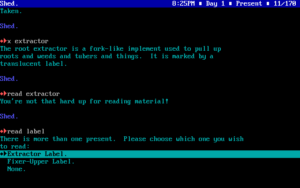
Just look at this! T-Zero offers a menu for disambiguation as one of the conveniences it’s absolutely rife with.
But now, having praised T-Zero to the skies, I have to tell you about its one tremendous flaw: this game is just way, way too hard. A goodly chunk of the puzzles involve wordplay of the Nord and Bert variety, the sort of thing that delights some players and drives others — especially players who don’t have English as a first language — absolutely crazy. This in itself may thus be enough reason for some of you to reject a game, but we’re just getting started with the litany of barriers to solving it. T-Zero muddies the waters further than Nord and Bert did in that it doesn’t have discrete sections devoted to discrete kinds of wordplay; you never know, in other words, whether it’s looking for an idiom or an anagram or an allusion. Or, for that matter, whether it’s looking for something else entirely: there are also plenty of traditional puzzles here, grounded in real-world — or at least text-adventure — physics. And then we have to throw onto the pile the fact that this is a big game with a lot of locations to explore, and over several time periods at that. Because the descriptions of these intricate landscapes are drawn in such loving detail, it’s really, really hard to know for sure which locations contain puzzles waiting to be solved and which just exist for you to drink in on their own terms.
Not helping the situation is a tendency for the parser, so flexible in most ordinary tasks, to suddenly become needlessly persnickety in some specific situations, with failure messages that can be not just unhelpful but actively misleading. For instance, at one point you need to tear the flyleaf out of a book. You need to type it exactly like that: “tear flyleaf out of book.” If you try to “pull flyleaf out of book,” you’re told that “your pull is next to nothing when it comes to the flyleaf.” Far worse, if you just type, “tear flyleaf,” you’re told that there’s “no reason to play the vandal”; if you’re foolish enough to take the game at its word here, you’ll never solve it. There aren’t heaps of situations like this one, but there are more than enough to ruin an otherwise brilliant game for its player even absent the other questionable design choices.
That said, it must also be admitted that there is a partial solution to all these problems built right into the game. Among its other technical wonders, T-Zero includes a full-fledged adaptive hint system that keeps track of your progress and doles out context-specific hints for each location — the first such system I’m aware of in the history of interactive fiction. It breaks my heart, but I have to recommend to any of you who choose to play this game that you use it liberally, typing “hint” as a matter of course in each location you visit. Sometimes doing so gives away the full answer to the puzzle; sometimes it at least leaves a little for you to work out on your own. The former in particular is far from ideal, but what else can you do if you’d prefer not to beat your head for hours and hours against this brick wall of a game? The shame, of course, is that there are some very good puzzles here which you won’t be able to enjoy thanks to the bad ones. Ah, well… at least T-Zero‘s wonderful version of the maze-that-isn’t-really-a-standard-maze, almost as venerable a text-adventure tradition by this point as mazes of the old drop-and-plot variety, isn’t entirely spoiled by the hint system.
Having to recommend that you play T-Zero in this way really does pain me, not least in that it destroys all the critical goodwill I have toward every other aspect of the game. As you regular readers know, I’m deeply skeptical of the idea of the “great, as long as you have a walkthrough” species of adventure game. Adventure games are interactive works, and when their interactivity fails them it’s hard for me to see why one should bother with them. As I once put it, “an adventure game that cannot be solved unaided, or for that matter that can be solved only through sheer doggedness and refusal to give in to tedium, is a bad game.”
But I will say now that this particular bad game comes closer than any other to making me recommend that you go ahead and play it anyway using the hints, just to experience the prose and the beautiful environment it evokes. In the end, you’ll have to decide for yourself whether this failure that by all rights should have been numbered among the all-time greats is worth your time. Once again, you can download an almost-ready-to-play version from this site. The only other thing you need is DOSBox.
